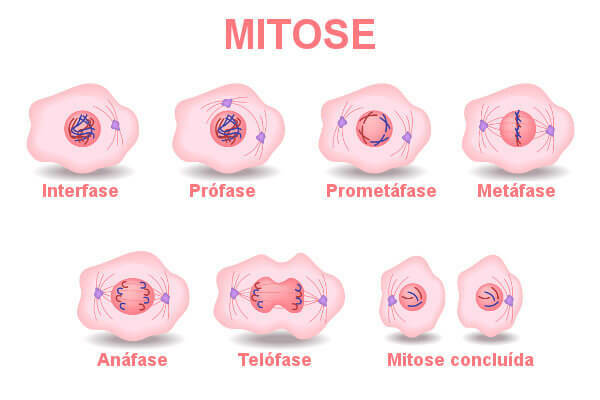Cell division is the process by which a mother cell gives rise to daughter cells.
Through this process, unicellular cells reproduce and multicellular ones multiply.
The frequency of cell divisions varies with the type and physiological state of each cell.
In the human body, for example, some cells are constantly multiplying. An example is the cells of the epidermis and bone marrow, which multiply to replace the cells that die.
However, some more specialized cell types such as neurons, red blood cells and muscle cells never divide.
cell cycle
It is the period that begins with the origin of the cell, from a cell division and ends when it divides into two daughter cells.
The cell cycle is divided into two stages: a interface and the cell division.
In eukaryotes there are two types of cell division: a mitosis and the meiosis.

interface
It is the stage where the cell is not dividing.
It is the longest period of the cell cycle, approximately 95% of the time.
At this moment, several facts occur that make cell division possible, such as: DNA replication, centrioles division and protein production.
The interphase is subdivided into three phases: G1, S and G2.
In the G1 phase, which precedes DNA duplication, cells increase in size, produce RNA and synthesize proteins.
In the S phase, DNA synthesis takes place. The amount of DNA in the cell's nucleus is replicated. Remember that replication means the process of duplicating the DNA molecule.
Before any cell division there is DNA duplication during interphase.
The G2 phase corresponds to the interval between DNA synthesis and mitosis. The cell continues to grow and produce proteins.
Learn more about interface.
Cell Division Types
Mitosis
It is the type of cell division that the mother cell, haploid (n) or diploid (2n), gives rise to 2 daughter cells with the same number of chromosomes of the mother cell.
It's an equational division.
Mitosis is performed when there is asexual reproduction.
Functions of mitosis
- Tissue growth and regeneration;
- Healing;
- Formation of gametes in vegetables;
- Zygote divisions during embryonic development.
Learn more about mitosis and its phases.
Meiosis
It is the type of cell division in which the mother cell, always diploid (2n), with double chromosomes, originates through two successive divisions, four daughter cells with half the number of chromosomes in the cell mom.
It is a division of the reduction type.
Meiosis Functions
- Gamete formation in animals;
- Formation of spores in vegetables.
Learn more about meiosis and its phases.
Learn the differences between the two cell division processes at: Mitosis and Meiosis.
solved exercises
1) (UFLA) - In multicellular beings, mitosis is a process whose main function is:
a) cell movement
b) the production of gametes
c) energy production
d) gene expression
e) growth.
e) growth.
2) (UECE) - Mitosis and Meiosis are types of cell divisions, which have the following differential characteristics:
a) mitosis occurs exclusively in somatic cells, never in germplasm.
b) meiosis enables genetic recombination, a constituent ingredient of genetic variability.
c) mitosis and meiosis alternate in the asexual reproduction process of unicellular beings.
d) mitosis and meiosis always occur in the same living organism.
b) meiosis enables genetic recombination, a constituent ingredient of genetic variability.
3) (Fuvest) - In the process of cell division by mitosis, we call the mother cell that which enters into division and daughter cells, those that form as a result of the process. At the end of a cell's mitosis, you have:
a) two cells, each carrying half of the genetic material that the mother cell received from its mother and the other half, newly synthesized.
b) two cells, one with the genetic material that the mother cell received from its mother and the other cell with the newly synthesized genetic material.
c) three cells, that is, the mother cell and two daughter cells, the latter with half of the genetic material that the mother cell received from its mother and the other half, newly synthesized.
d) three cells, that is, the mother cell and two daughter cells, the latter containing newly synthesized genetic material.
e) four cells, two with newly synthesized genetic material and two with the genetic material that the mother cell received from its mother.
a) two cells, each carrying half of the genetic material that the mother cell received from its mother and the other half, newly synthesized.
See too: haploid and diploid cells


